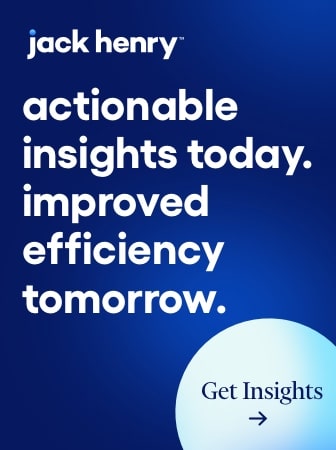LendingClub has emerged as a trailblazer in the modern banking landscape — challenging traditional models and redefining the way consumers access financial services. Since it acquired online bank Radius Bank in 2021, the company has undergone a significant transformation, navigating the complexities of a changing macroeconomic environment while staying true to its mission of empowering customers through innovative lending solutions.
In this insightful conversation with Jim Marous on the Banking Transformed podcast, LendingClub CEO Scott Sanborn shares his perspective on the company’s journey post-acquisition, the advantages of their unique marketplace model and the strategies they’re employing to engage members beyond lending. As the discussion delves into the potential impact of AI on the banking industry, Sanborn offers a glimpse into LendingClub’s vision for the future — and the lessons he’s learned along the way.
Listen: LendingClub’s Vision for the Future of Digital Banking
Q: What have been some of the key focus areas for LendingClub since acquiring Radius Bank?
Scott Sanborn: Since acquiring Radius Bank, we’ve focused on two key areas: transforming our financials and transforming our strategy. On the financial side, we’ve leveraged the bank charter to build a more resilient and profitable company. We’ve nearly doubled our book value and achieved 12 quarters of profitability in a row despite the macroeconomic pressures and uncertainties.
The bank charter has allowed us to lower costs by eliminating issuing bank partnerships and warehouse financing. It has also enabled us to increase revenue by building a balance sheet and earning interest income. We now have the flexibility to sell some loans and keep others, earning three times as much on the loans we retain.
On the strategy side, we’ve focused on better serving our customers through continued innovation in lending and expanding beyond lending to offer spending and savings products. We’ve evolved our mobile technology platform, built award-winning banking products and added mobile servicing to our app, creating a full mobile-first ecosystem.

Solving the Deposit Puzzle: Strategies for Growth in Rate Uncertainty
Join Kasasa’s insightful webinar to explore effective strategies for navigating the complexities of rate uncertainty.
Read More about Solving the Deposit Puzzle: Strategies for Growth in Rate Uncertainty

The unfair advantage for financial brands.
Offering aggressive financial marketing strategies custom-built for leaders looking to redefine industry norms and establish market dominance.
Q: How has LendingClub positioned itself to weather the ups and downs of the macroeconomic environment over the last few years?
Sanborn: We’ve had to stay agile and proactive to navigate the challenging macroeconomic environment. One key aspect has been managing credit in a dynamic environment.
We’ve adapted our servicing and underwriting strategies to account for changes like rent increases outpacing mortgage increases, the resumption of student loan payments and the potential impact of inflation on our customers.
We’ve also had to lean into our costs, making difficult decisions like reducing headcount to ensure we remain comfortably profitable without relying on rate changes.
Additionally, we’ve had to innovate in how we operate our model, introducing new structures like our structured certificates program, which allows us to continue growing our balance sheet while managing risk effectively.
The Power of the Marketplace Model
Q: How does LendingClub’s marketplace model differ from traditional banking and what advantages does it offer?
Sanborn: Our marketplace model, where we sell a portion of the loans we originate, offers several key advantages. From a financial perspective, it provides high-end-period earnings with no capital usage, allowing us to be both high-growth and high-profit, which is challenging under CECL accounting.
Strategically, the marketplace model allows us to serve a broader customer base, including those with lower credit scores, that we wouldn’t necessarily put on our balance sheet. This makes our marketing more efficient and enables us to leverage the different risk appetites of our investors to offer better rates to borrowers.
The model also provides valuable insights from our sophisticated buyers, helping us optimize pricing, identify potential credit issues and test new hypotheses. This feedback loop contributes to our ability to continuously improve our underwriting and risk management.
“Whether it’s navigating a global pandemic, a banking crisis, or a shift in investor sentiment, we’ve had to continuously evolve our model and strategies to stay ahead of the curve..”
— Scott Sanborn, LendingClub
Q: How has the acquisition of Radius Bank impacted LendingClub’s ability to fund loans and manage risk?
Sanborn: The acquisition of Radius Bank has been transformative for LendingClub. With the bank charter, we’ve been able to lower our funding cost by using deposits instead of more expensive and less stable warehouse lines or capital markets.
We’ve dramatically grown our deposit base and balance sheet, which provides a more stable foundation for our lending activities. The goal is to build a balance sheet large enough to deliver solid returns for shareholders, so the marketplace becomes more of an “icing on the cake” that helps us manage risk and adapt to market conditions.
The bank charter also gives us more control over credit decisions and loan performance. We have the flexibility to hold loans on our balance sheet and earn recurring interest income, which has been particularly valuable in navigating the recent banking crisis and shift in investor demand.
Engaging Members Beyond Lending: Expanding Products and Services
Q: How has LendingClub’s focus on customer acquisition and engagement evolved since the acquisition?
Sanborn: Since the acquisition, we’ve significantly expanded our customer base: growing from under 3 million to nearly 5 million members. We’ve also enhanced our product suite to better serve our core use case of helping customers refinance high-interest credit card debt.
One key focus has been on creating an engagement platform that keeps members coming back to LendingClub. We’ve found that when customers use our banking services or sign up for credit monitoring, their engagement with us increases significantly. This provides more opportunities for us to understand their financial needs and offer tailored solutions.
We’re also using our data to be more targeted and efficient in our customer acquisition. Rather than a “spray and pray” approach, we’re able to identify specific opportunities, like refinancing an auto loan and present pre-approved offers that are more likely to convert. This data-driven approach helps us build trust and create value for our members at every stage of their financial journey.
Harnessing the Potential of AI and Generative AI
Q: How does LendingClub envision AI and generative AI enhancing its operations and customer experience?
Sanborn: We see tremendous potential for AI and generative AI to transform nearly every aspect of our business, from fraud detection and risk management to customer service and marketing. As a data-driven company, we’re well-positioned to leverage these technologies to drive efficiency, personalization and innovation.
Some of the areas we’re exploring include using AI to enhance our credit decision models, automate routine tasks and provide more personalized recommendations and advice to our members. With generative AI, there’s an opportunity to create more engaging and interactive experiences, like conversational interfaces and dynamic content generation.
We’re also excited about AI’s potential to help us identify new opportunities and insights from our vast dataset. By uncovering hidden patterns and trends, we can stay ahead of the curve and develop products and strategies that better meet our customers’ evolving needs.
Of course, as a regulated financial institution, we have to be thoughtful about how we implement these technologies and ensure we have the right governance and controls in place. But overall, we believe AI will be a key driver of our future growth and success.
Q: What lessons have you learned over the past few years that have shaped his vision and leadership style at LendingClub?
Sanborn: One of the biggest lessons I’ve learned is the importance of balancing short-term execution with long-term strategic planning. In an environment as dynamic as ours, it’s easy to get caught up in the day-to-day firefighting and lose sight of the bigger picture.
To counter this, we’ve developed a disciplined operating rhythm where we regularly assess our short-term priorities and long-term vision, stress test our assumptions and adapt our plans as needed. This helps us stay aligned as a leadership team and ensures we’re allocating our resources effectively.
Another key lesson has been the value of resilience and adaptability. Whether it’s navigating a global pandemic, a banking crisis, or a shift in investor sentiment, we’ve had to continuously evolve our model and strategies to stay ahead of the curve. This requires a certain level of comfort with change and uncertainty, as well as a willingness to take calculated risks.
“We win when [customers] win, whether that’s by helping them pay off debt faster, save money on interest or build their credit. This requires a fundamental shift in mindset from seeing customers as sources of revenue to seeing them as long-term partners.”
— Scott Sanborn, LendingClub
Looking Ahead: LendingClub’s Vision for the Future of Banking
Q: What opportunities does LendingClub see for growth and expansion in the coming years?
Sanborn: We see a tremendous opportunity ahead of us as we continue to execute our vision of becoming a full-spectrum, member-centric digital bank. With our unique combination of lending expertise, data capabilities and banking infrastructure, we’re well-positioned to disrupt the traditional banking model and create a better financial future for our members.
In the near term, we’re focused on expanding our core lending business, particularly in the credit card refinancing space. As rates come down and consumer debt levels remain high, we believe there will be a significant demand for affordable, transparent solutions that help people take control of their debt.
At the same time, we’re investing in new products and capabilities that will allow us to serve our members more holistically. This includes building out our revolving credit platform, expanding our auto refinancing offerings and exploring new verticals like small business lending.
Longer-term, our goal is to become the go-to financial partner for our members, providing a full suite of products and services that help them achieve their goals at every stage of their lives. Whether it’s helping them save for a rainy day, finance a major purchase, or plan for retirement, we want to be there every step of the way.

Q: What are traditional financial institutions missing when it comes to the marketplace opportunity and serving customers in the digital age?
Sanborn: I think one of the biggest blind spots for traditional banks is the way they approach customer relationships. For decades, the model has been based on maximizing short-term profits through fees, cross-selling and upselling, often at the expense of the customer’s long-term financial health.
In contrast, our approach is to align our incentives with our members’ success. We win when they win, whether that’s by helping them pay off debt faster, save money on interest or build their credit. This requires a fundamental shift in mindset from seeing customers as sources of revenue to seeing them as long-term partners.
Another key differentiator is our ability to leverage data and technology to create more personalized, seamless experiences. Traditional banks are often held back by legacy systems, siloed data and a product-centric approach that makes it difficult to meet the evolving needs of digital-native consumers.
Ultimately, I believe the future of banking belongs to those who can combine the trust and stability of a regulated institution with the innovation and agility of a technology company. That’s the vision we’re pursuing at LendingClub and we’re excited to lead the way in shaping the next generation of financial services.
For a longer version of this conversation, listen to “LendingClub’s Vision for the Future of Digital Banking” on the Banking Transformed podcast with Jim Marous. This Q&A has been edited and condensed for clarity.
Justin Estes is an award-winning writer, strategist, and financial marketing expert with expertise in banking, investments, and fintech. His clients include the NYSE, Franklin Templeton, Credit Karma, Citi and, UBS, and his work has appeared in Forbes, Barrons and ThinkAdvisor as well as The Financial Brand.







